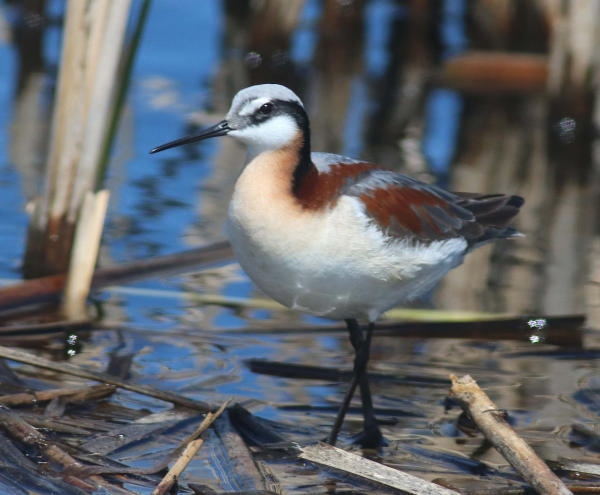
Female Wilson’s Phalaropes are more colorful than males during the nesting season.

Male Wilson’s Phalaropes incubate the eggs and care for the hatchlings.
|
Phalaropes may be the most spectacular of all shorebirds, not only because of their colorful breeding plumage, buoyant flights and lobed toes, but especially because of their surprising sexual role reversals. Females are slightly larger than males, and during the nesting season they are much more colorful. They try to attract males by displaying to a potential mate and by chasing other females away.
After attracting a male and mating with him, the male makes a number of nest scrapes. The female chooses one scrape in which to lay her eggs, which she lines with grasses after laying the first egg. The male incubates the clutch of eggs and raises and protects the precocious hatchlings. This mating system is known as monogamous (one male and one female). But after laying a clutch of eggs for the first male to incubate, some females repeat the mating process with a second male, a practice known as sequential polyandry (more than one male, but one at a time).
Phalaropes are also famous for their spinning feeding behavior, during which a swimming individual tightly spins its body in circles to create a vortex in the water that pulls small aquatic invertebrates toward the top of the water where the bird spears or picks tiny prey from the water and swallows it.
There are three phalarope species worldwide. Wilson’s Phalaropes are only found in the Western Hemisphere, although the other two species, Red-necked and Red Phalaropes, nest in Arctic tundra surrounding the Northern Hemisphere. The two Arctic-nesting species winter in open oceans to the south.
Range: The nesting range of Wilson’s Phalaropes is the interior of western North America. They winter in the mountains of South America in shallow saline or alkaline wetlands in the altiplano region of southeast Peru, western Bolivia, northern Chile and northwest Argentina, and freshwater wetlands to the south.
Habitats: Preferred nesting habitat is adjacent to shallow freshwater or saline wetlands and shorelines, sometimes in the open, but often in fine grasses or sedges.
Mating: Led by the female, mating displays include aerial displays and calls; the female also swims near the male, stretching her neck toward him while calling. Mating behavior often includes territorial aggression by females toward other females. Some females may practice sequential polyandry (see above).
Nest Sites: On damp ground on or near a wetland shoreline; sometimes on a small island in a shallow wetland or a wet meadow area. Nest may be in the open or concealed among grass or sedges. Occasionally small loose nesting colonies are formed.
Clutch Size: 3 or 4 light tan eggs marked with short dark lines.
Incubation Period: 18 to 24 days; male begins incubating after the clutch is complete, which dictates that the eggs hatch at about the same time. Hatchlings are precocious and leave the nest soon after hatching under the direction and protection of the male.
Fledging: Less than 3 weeks.
Food: Primarily aquatic insects and insect larvae, brine shrimp and brine flies.
Conservation: Wilson’s Phalaropes are 1 of 16 shorebird species to be considered of “Least Conservation Concern.”